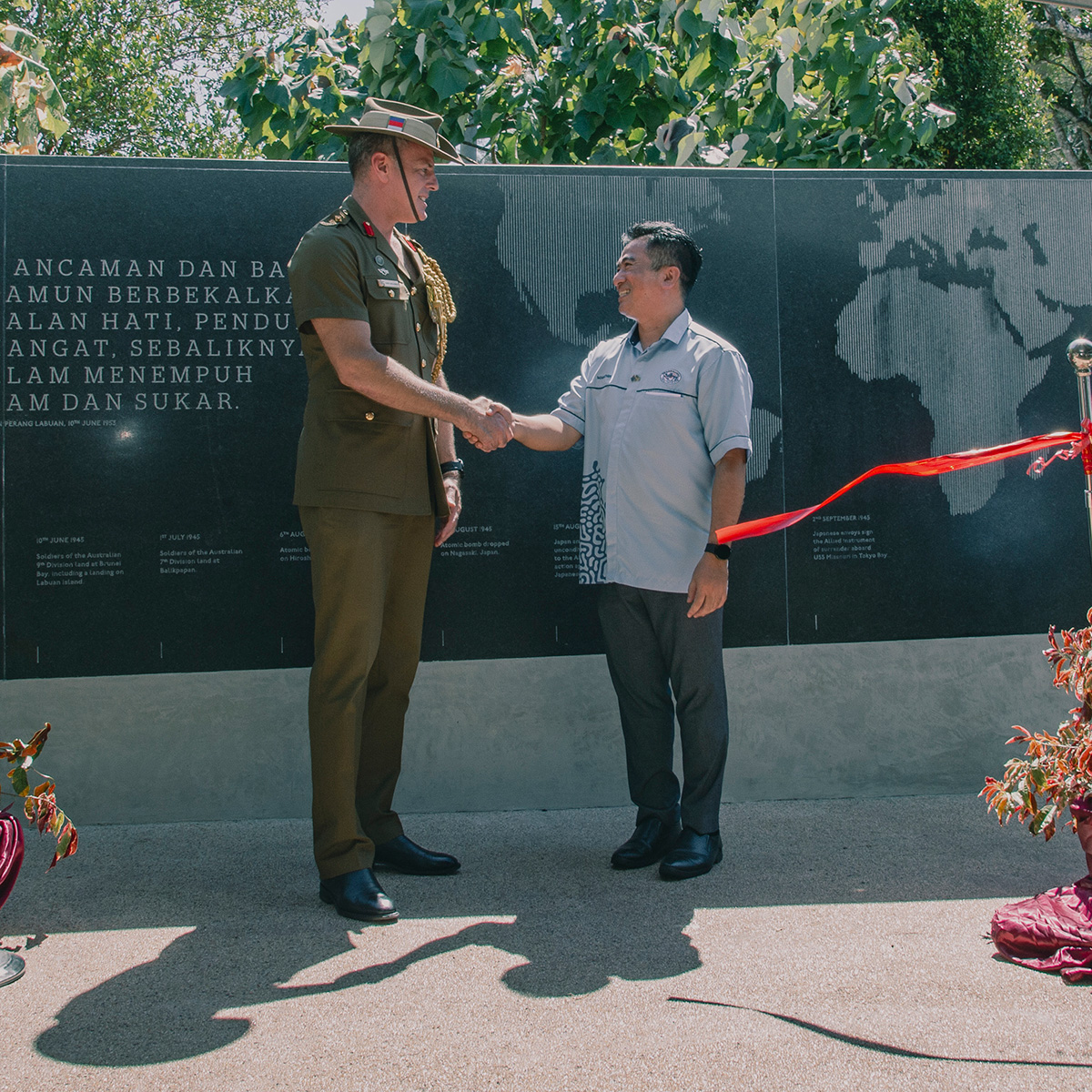Malaysia
On this page
Malaysia was the scene of both victory and dreadful tragedy for Australia during the war in the Pacific against the Japanese forces in the Second World War. Three official memorials in Malaysia commemorate both the trials endured by Australians and our ultimate triumph.
Back to topParit Sulong Memorial
The Parit Sulong Memorial commemorates the Battle of Muar and its tragic aftermath during the Second World War. The memorial is situated within the Community Park at Parit Sulong, near by the site of the massacre. Consisting of a central memorial area and two interpretive panels, the Memorial is a dignified, simple marker to this significant and tragic event.
History of the Battle of Muar
In January 1942 an Australian and Indian force engaged in a desperate battle against the Japanese Imperial Guards Division that ended at Parit Sulong.
Weakened by defeat at the Muar River, the 45th Indian Brigade and a support battery of the 2/15th Field Regiment retreated and an Australian force was sent to restore their lost position. The 2/29th Battalion with a troop of the 4th Anti-Tank Regiment was deployed first. The 2/19th Battalion followed, with men of 8th Division Signals maintaining communications.
Surrounded and outnumbered, this combined force was ordered to fight its way out by the senior surviving officer, Lieutenant-Colonel Charles Anderson, 2/19th Battalion. Fighting hand to hand and under incessant aerial and artillery bombardment, they reached the outskirts of Parit Sulong to discover that the village and the only avenue of withdrawal, the bridge spanning the Simpang Kiri River, were already in Japanese hands.
The Retreat
Although Anderson's men gained control of the village they were unable to force the enemy from the bridge. On the morning of 22 January, Anderson, fearing annihilation, ordered his men to break out through the jungle. During the battle and retreat over 300 Australians died, however, with the assistance of the local people and especially the Chinese community many of those who survived later reached British lines at Yong Peng.
For his brave leadership, determination and outstanding courage during the battle, Lieutenant-Colonel Charles Anderson received the British Commonwealth's highest award, the Victoria Cross.
The Massacre
In the aftermath of the battle nearly 150 severely wounded Australian and Indian soldiers were left together at Parit Sulong under the charge of Captain Rewi Snelling, who indicated their willingness to surrender to the advancing Japanese. These soldiers were left behind in the expectation that they would be treated humanely. Instead, their Japanese captors herded them into buildings on the western side of the bridge, mistreated them and denied them medical attention.
Late on the afternoon of 22 January 1942, the prisoners were forced outside, machine-gunned, doused with petrol and set alight. Only three men were known to have survived. Sadly, this massacre was not an isolated incident.
The Survivors
Sergeant Ron Croft, Lieutenant Ben Hackney and Private Reg Wharton all survived the massacre by feigning death amongst the carnage and sustaining wounds from kicking and bayonets in silence and stillness.
After this, with extensive wounds, they made their escapes with the help of the local Malaya and Chinese communities, even though their presence put these communities in grave danger.
When the fighting had passed, the Japanese established a Kempei Tei (military police) headquarters in the village. Many local people, including those suspected of assisting Australian or Indian soldiers, were executed or severely mistreated, while others were forced to flee. Harsh treatment continued until the end of the Japanese occupation of Malaya (now Malaysia) in September 1945.
After the War
After the war, investigators pursued those Japanese who had been involved in these tragic events. The evidence of Lieutenant Ben Hackney, one of the survivors, was instrumental in bringing Lieutenant-General Nishimura, commander of the Imperial Guards Division, to justice. He was hanged for war crimes in 1951.
Those left behind at Parit Sulong...met a fate largely typical of what many had already experienced, and many more were to experience, at the hands of the Japanese Lionel Wigmore, The Japanese Trust
Further reading
The Bridge at Parit Sulong
by Lynette Ramsey Silver
Massacre at Parit Sulong
by Gilbert Mant
A History of the 2/29 Battalion – 8th Australian Division AIF
by R W Christie
The Grim Glory of the 2/19 Battalion AIF
by the 2/19th Battalion AIF Association
See further:
Back to topFriendship Windows at St Michael and All Angels, Sandakan
Family and friends of those who died at Sandakan raised funds to install stained-glass Friendship Windows, at the Anglican Church of St Michael and All Angels, Sandakan. These are open to the public for viewing, from 2.30-3.30 pm, Mondays to Saturdays.
Back to topSurrender Point Memorial, Labuan Island
The Surrender Point Memorial was rededicated on 27 February 2024 following a small ceremony.

Pictured above is COL Corey J Shillabeer, Australian Defence Advisor to Malaysia and Tuan Mahathir Bin Abd. Hamid, representing the Labuan Corporation.
On 10 September 1945, Lieutenant-General Masao Baba, Commander of the 37th Japanese Army surrendered to Major General George F Wootten of the 9th Australian Division at Surrender Point, one of several such ceremonies that concluded the war in the Pacific in the Second World War.
The Surrender Point Memorial on Labuan Island is on the site of the surrender. It is set in a small beach-side park near Timbalai overlooking the South China Sea on the western side of Labuan Island.
For further information or enquiries, please contact us at overseas.memorials@dva.gov.au
Back to top